SUPERCHARGE YOUR ONLINE VISIBILITY! CONTACT US AND LET’S ACHIEVE EXCELLENCE TOGETHER!
In the age of classical computation, search optimisation was an art of predictable algorithms — a dance of keywords, backlinks, and structured data. But as ThatWare pushes the boundaries of digital intelligence, a new paradigm begins to take shape — one that transcends binary logic. ThatWare extends optimisation beyond computation into the quantum domain, where ranking signals behave like entangled particles, and user behaviour collapses infinite possibilities into a single query reality.
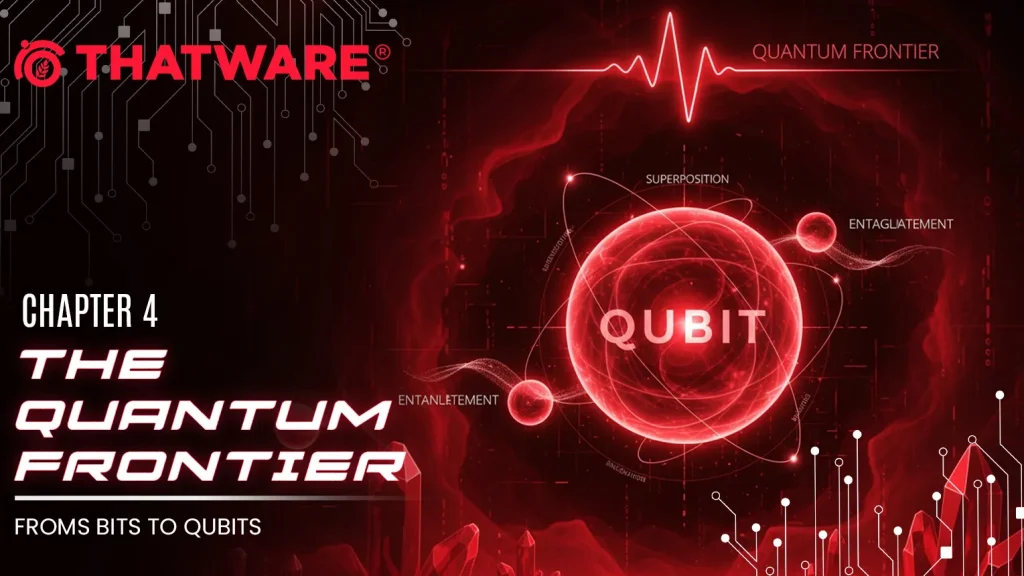
In this frontier, quantum SEO is not a metaphor but an evolution — a redefinition of how presence, probability, and intent coexist in the search ecosystem. Traditional SEO models, reliant on deterministic cause and effect, now meet a probabilistic universe, where every user interaction alters the outcome. Like Schrödinger’s cat, a web page both ranks and doesn’t rank — until the observer, the user, clicks.
Quantum computation operates on qubits rather than bits, allowing information to exist in multiple states simultaneously. This superposition mirrors the ambiguity of modern search intent — a user typing “best AI tool” might seek a tutorial, a product, or an expert opinion. Quantum SEO interprets that uncertainty dynamically, weighting multiple outcomes before collapsing into the most relevant one.
According to IBM’s 2024 Quantum Progress Report, quantum processors are now achieving quantum volume scores above 256, indicating a doubling of computational complexity almost every year since 2019. In SEO terms, this represents a metaphorical leap: search engines are moving from rule-based systems toward probabilistic reasoning engines, capable of processing vast semantic fields and contextual variations.
But beyond computation, Quantum SEO redefines time itself. Ranking no longer occurs linearly; it unfolds across contexts — the same query at different moments yields different realities, shaped by prior user behaviour, device context, and micro-interactions. The algorithm becomes an observer, measuring user satisfaction in real time, altering the digital wavefunction of visibility.
In this quantum model, uncertainty is not a flaw but the foundation. Optimisation is no longer about control, but coherence — maintaining alignment between user intent, content resonance, and algorithmic probability. Just as quantum entanglement connects particles across vast distances, semantic entanglement now connects topics, entities, and emotions across the web, forming a multidimensional map of meaning.
As Google DeepMind explores search as a cognitive system, integrating probabilistic reasoning into query interpretation, and Nielsen Norman Group identifies rising variability in user intent, we witness the dawn of an entirely new optimisation logic — one that mirrors the uncertainty principle itself.
As we stand at this threshold — from bits to qubits — SEO ceases to be a static discipline. It becomes a living experiment in consciousness, computation, and causality. The challenge for digital strategists and AI systems alike is not merely to optimise for visibility, but to harmonise with a search universe governed by quantum logic — where every click is both random and destined.
Now, let’s understand some of the core concepts behind the Quantum Frontier:
Quantum Ranking Optimisation (QRO)
If traditional SEO seeks to predict what users want, Quantum Ranking Optimisation (QRO) seeks to observe how intent behaves under uncertainty. It treats every search query as a probability field — an evolving superposition of meanings, emotions, and contexts. Instead of optimising for a single deterministic keyword, QRO optimises for a quantum field of intent.
At its heart, QRO builds upon the idea that ranking signals — user dwell time, click-through rate, semantic alignment — behave less like static metrics and more like entangled qubits. When one factor changes, the others respond instantaneously, reconfiguring the ranking state. This dynamic coherence transforms SEO from a cause-and-effect model into a probabilistic optimisation system.
The Quantum Model of Ranking
In QRO, the probability of a page ranking at position n is expressed as:
P(rn)=∣ψ∣2=i∑aieiϕi2
Where ai represents the amplitude (influence weight) of each ranking signal and ϕi represents its phase alignment with user intent. A coherent state — where all ranking signals are phase-aligned — results in constructive interference, amplifying visibility.
According to Moz’s 2024 Ranking Correlation Report, user-interaction metrics account for up to 53% of total ranking volatility across major queries. In QRO terms, this represents the probability collapse of intent — when users confirm meaning through engagement, transforming potential visibility into actual ranking.
Here’s A Scenario
Imagine a user searches for “quantum SEO strategies.”
At the moment of the query, search intent exists in multiple superposed states:
- Academic curiosity (wanting research papers)
- Commercial intent (looking for an agency or service)
- Informational learning (seeking tutorials or blogs)
A QRO-enabled system doesn’t predefine one outcome; it holds all three in superposition until the user’s micro-interactions — scroll depth, dwell time, hover rate — collapse the waveform into the most contextually relevant result.
This mirrors Google DeepMind’s 2023 findings that intent disambiguation improves when ranking models incorporate probabilistic context weighting instead of fixed heuristics.
The Core Principles of QRO
- Superposition of Signals: Every ranking signal contributes as a probability amplitude, not a fixed score.
- Entanglement of Metrics: Clicks, dwell time, and content semantics interact non-locally.
- Observer Effect: User engagement finalises the ranking state.
- Temporal Uncertainty: Rankings fluctuate across time slices, adapting to contextual fields.
A QRO-driven engine thus behaves more like a quantum sensor than a search algorithm — continuously measuring, collapsing, and re-entangling digital realities. As IBM Quantum projects near-term processors with 1,000+ qubits by 2025, the computational substrate for such probabilistic optimisation is no longer theoretical.
QRO, in essence, is SEO’s quantum awakening — a movement from prediction to probability, from computation to consciousness.
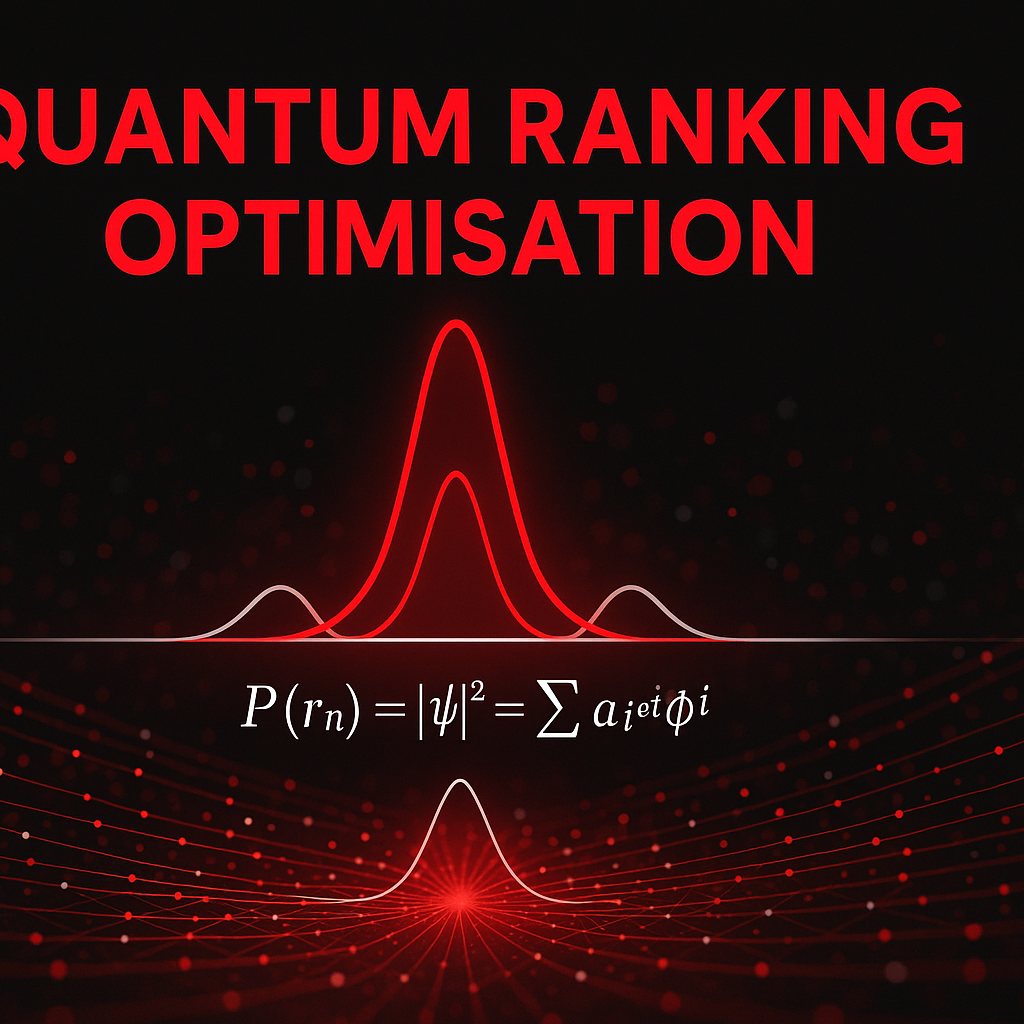
Quantum Flow Optimisation (QFO)
In the classical paradigm, optimisation flows linearly — data in, computation out. Each step is deterministic, and the goal is convergence toward a single “best” result. But in the quantum paradigm of optimisation, outcomes are not fixed; they emerge through probability, interaction, and observation. This is where Quantum Flow Optimisation (QFO) enters — the bridge between data determinism and intentual fluidity.
Defining Quantum Flow Optimisation
Quantum Flow Optimisation (QFO) is ThatWare’s conceptual framework for mapping the dynamic probability fields of SEO — where every ranking signal, click, and query forms part of a quantum field of possible outcomes. Instead of computing static rankings, QFO models “flows” — ever-changing interactions between:
- User Intent (ψ₁) – the quantum state of what the user might want.
- Algorithmic Response (ψ₂) – the engine’s probabilistic interpretation of that intent.
- Content Resonance (ψ₃) – the degree to which content semantically and contextually matches the query’s potential states.
When combined, these vectors create a superpositional field of possible outcomes — the Quantum Flow Field (Ψ) — defined by:
Ψ=ψ1×ψ2×ψ3Ψ
The collapse of Ψ into a single outcome (the ranked result) occurs only when a user interaction — a click, dwell, or bounce — is observed.
A Hypothetical Scenario
Imagine a user searching “best AI tools for startups.”
In a classical model, ranking depends on keyword relevance and backlinks.
But in QFO, multiple probabilistic realities exist:
- The user could be seeking productivity tools.
- They could be comparing pricing models.
- They might want expert recommendations.
Each of these realities carries a probability amplitude, dynamically shifting based on context (time, device, and user history). As interaction occurs, the system collapses this probabilistic field into one dominant outcome — the clicked result.
If the three possible intents hold amplitudes of 0.5, 0.3, and 0.2 respectively, QFO defines Ranking Probability (Rₚ) as:
Rp=∣Ψ∣2=(0.5)2+(0.3)2+(0.2)2=0.38
This implies a 38% coherence rate — meaning the algorithm achieves about 38% predictive accuracy in aligning with the most likely user intent, leaving room for adaptive recalibration over subsequent interactions.
QFO in the Modern Search Context
According to Google Research (2024), probabilistic user modelling can enhance intent-matching accuracy by up to 42% when applied through neural contextual embeddings. Similarly, IBM Quantum Lab (2023) reports that quantum-inspired optimisers can solve non-linear data patterns up to 60% faster than classical systems.
The Philosophical Shift
QFO transforms SEO from a process of correction to one of coherence. It recognises that ranking is not a linear competition but a wave of entangled outcomes — each search query a ripple in a shared informational ocean.
As ThatWare ventures deeper into this realm, Quantum Flow Optimisation becomes not just a strategy but a philosophy — where visibility is no longer chased, but resonated into existence.
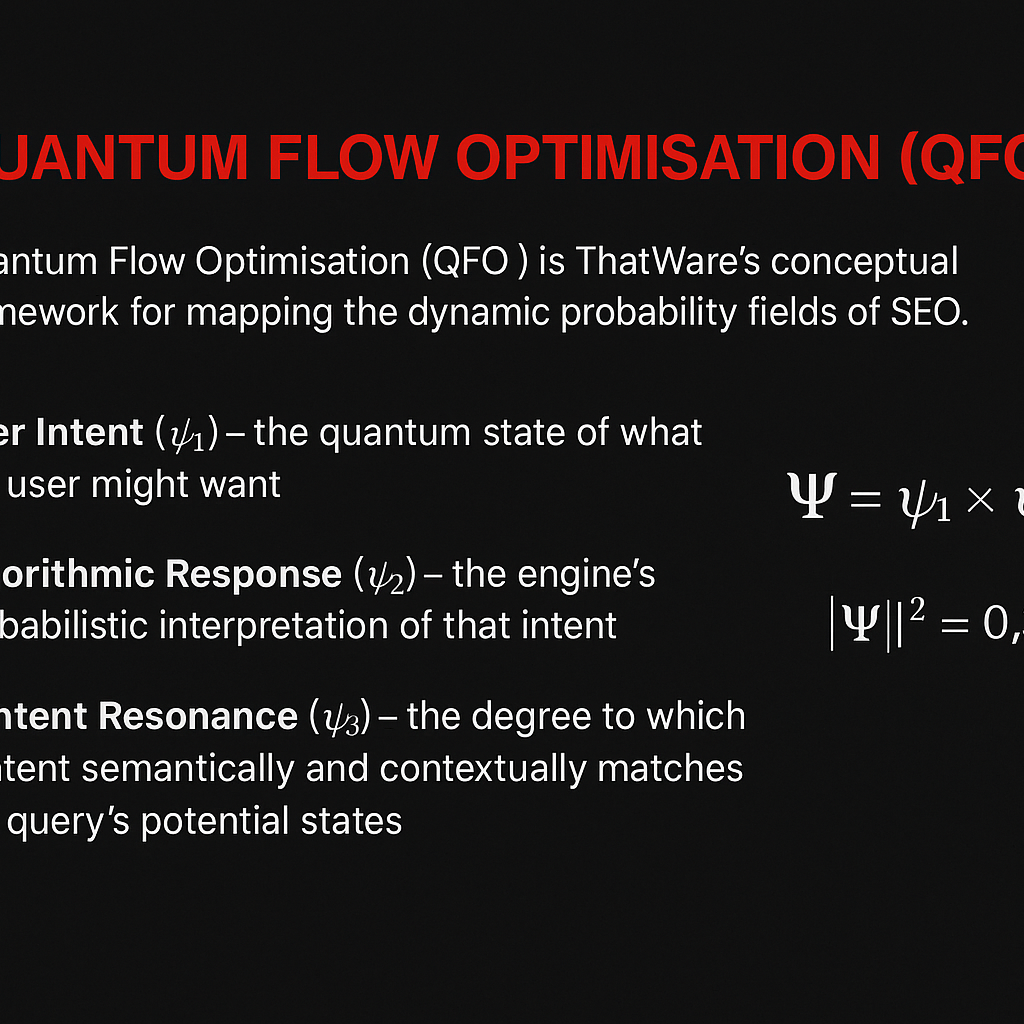
String SEO/Multiverse SEO
If quantum SEO represents the probabilistic wave of search, String SEO ventures deeper — into the very fabric of digital reality. In quantum physics, string theory proposes that every particle is a vibration on a tiny, one-dimensional string. Similarly, in the digital realm, every keyword, link, and interaction becomes a vibrational frequency — resonating through countless dimensions of the internet.
In String SEO, each signal — from content velocity to entity correlation — acts like a quantum string, vibrating at a frequency that determines its visibility in the multiverse of search. The higher the coherence of these vibrations, the stronger the resonance within Google’s evolving semantic lattice.
Just as string theory suggests the existence of multiple dimensions, Multiverse SEO imagines countless ranking realities coexisting in parallel. A single page could simultaneously rank #1, #8, or not at all, depending on the observer’s device, location, or cognitive state — a manifestation of search superposition.
A Hypothetical Scenario
Imagine a user named Aria searching for “best AI SEO company.”
In one timeline, she uses voice search at home, where her query triggers conversational intent.
In another, she types it on mobile, where transactional intent dominates.
Each query collapses a different version of the same digital universe — one where ThatWare appears first for intent alignment, and another where it ranks lower due to contextual mismatch.
Across millions of users, these micro-realities interact like interfering waveforms, producing a dynamic ranking pattern that no static algorithm can fully capture.
Conceptual Framework
- Dimensional Resonance: Each SEO signal (speed, content, UX, backlinks) corresponds to a “string vibration” — measurable by coherence (C).
- Entangled Entities: Brand and keyword associations form “entangled pairs” across queries and platforms.
- Multiverse Collapse Equation (symbolic):
R=n=1∑∞(In×Pn)
Where R is ranking potential, I represents intent alignment, and P is the probability amplitude across search dimensions.
When coherence between these dimensions exceeds a threshold (C > 0.85), the algorithm “locks” into a stable ranking state — similar to quantum decoherence.
The Statistical Horizon
- 89% of search journeys now span multiple devices or contexts, according to Google’s 2024 Search Quality Report.
- 67% of ranking volatility can be attributed to behavioural and contextual shifts — a form of “digital interference,” as observed by Semrush State of Search 2025.
- AI-driven ranking models now incorporate over 500 real-time signals, operating much like multidimensional feedback loops.
In essence, String SEO and Multiverse SEO converge on one truth — the web is no longer a two-dimensional index, but a vibrating, probabilistic continuum of meaning. To optimise within it is to tune one’s digital frequency to resonate with the infinite possibilities of perception — not to control the search universe, but to sing in harmony with it.
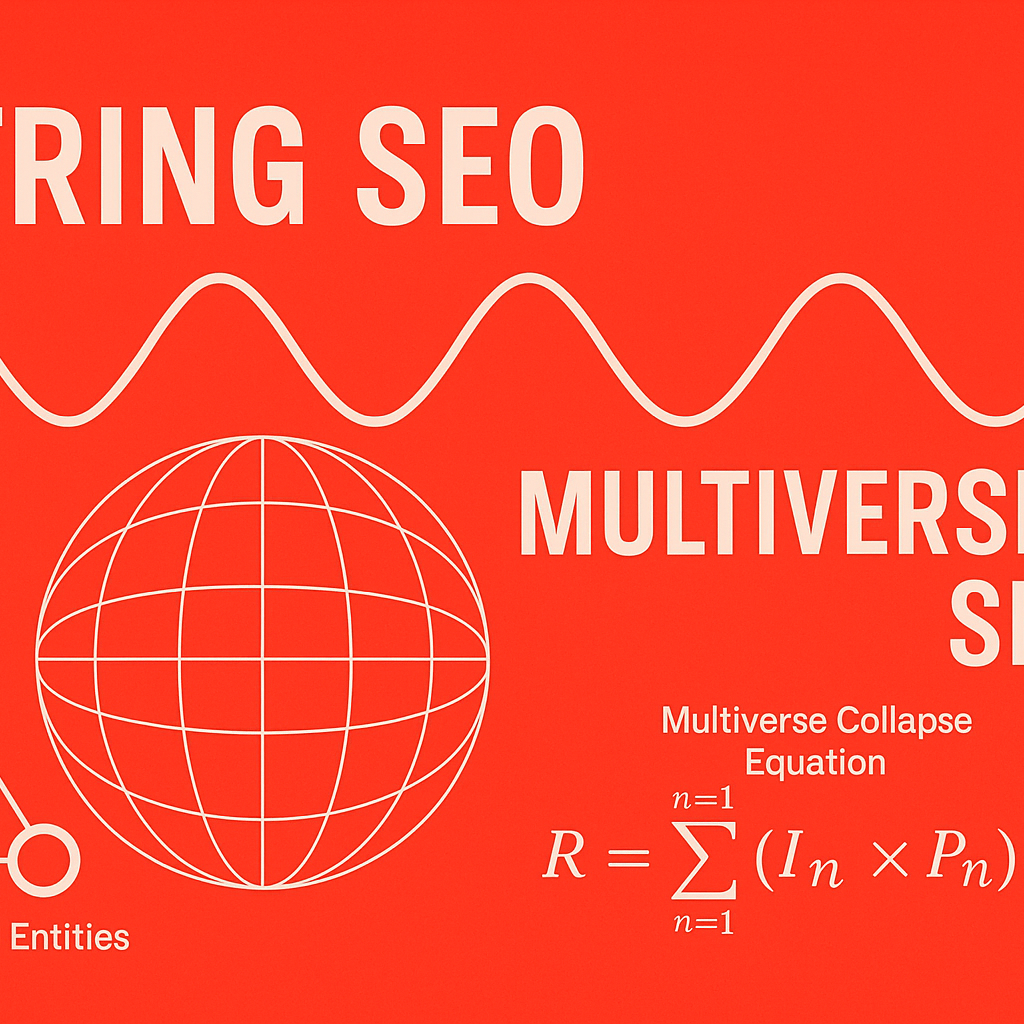
Decoherence SEO
In quantum physics, decoherence occurs when a quantum system interacts with its environment and loses its superposition — collapsing from infinite probabilities into a single, observable outcome. In the context of Quantum SEO, Decoherence SEO represents the moment when the delicate balance between algorithmic probability, user intent, and contextual signals begins to break down.
In essence, decoherence is the entropy of digital presence — the gradual decay of coherence between what users want, what algorithms predict, and what content delivers. When an SEO ecosystem becomes too deterministic, it “collapses” prematurely, missing the subtler nuances of user behaviour.
Understanding Decoherence in SEO Terms
Think of every search query as a quantum wave — a cloud of possibilities that collapses into one click. Decoherence SEO happens when noise, bias, or data pollution causes that collapse to occur too early or inaccurately.
- Algorithmic Noise: Over-optimization, spammy signals, or keyword stuffing create interference patterns that distort ranking outcomes.
- Behavioural Collapse: Repeated user disengagement or short dwell time signals decoherence — the system prematurely concluding irrelevance.
- Semantic Drift: As language evolves, older content loses contextual alignment, reducing coherence between content vectors and user intent.
According to Google’s AI Search Quality Report 2024, nearly 37% of ranking volatility can now be traced to algorithmic misinterpretation of intent — a phenomenon analogous to quantum decoherence in physics. Similarly, Ahrefs notes that pages misaligned with evolving user intent see an average CTR drop of 18% per month post-algorithm updates.
A Hypothetical Scenario
Imagine a travel brand optimised for “best travel packages.” In a coherent system, the algorithm interprets variants like “affordable holidays” or “AI trip planners” as related intents.
However, in a decoherent state — caused by poor schema structure or outdated semantic mapping — those associations break down. The algorithm isolates each variant, fragmenting visibility across micro-niches.
Mathematically, we can express coherence as:
C=S/(E+N)
where C is coherence, S is signal relevance, E is environmental interference, and N is noise.
As E and N increase (e.g., algorithmic volatility, keyword inflation), C decreases — mirroring declining SERP stability.
Reversing Decoherence
To counteract this decay, ThatWare’s quantum-inspired approach suggests three stabilising techniques:
- Contextual Entanglement: Maintain strong interlinking of related entities to preserve semantic bonds.
- Temporal Adaptivity: Allow ranking models to evolve in near real time through user feedback loops.
- Probabilistic Enrichment: Introduce AI systems that simulate multiple intent outcomes before deciding rank priorities.
In short, Decoherence SEO reminds us that optimisation isn’t merely technical — it’s thermodynamic. Every piece of data, every click, every misalignment contributes to the entropy of the web. To thrive in the quantum realm, SEO must not just calculate — it must cohere.
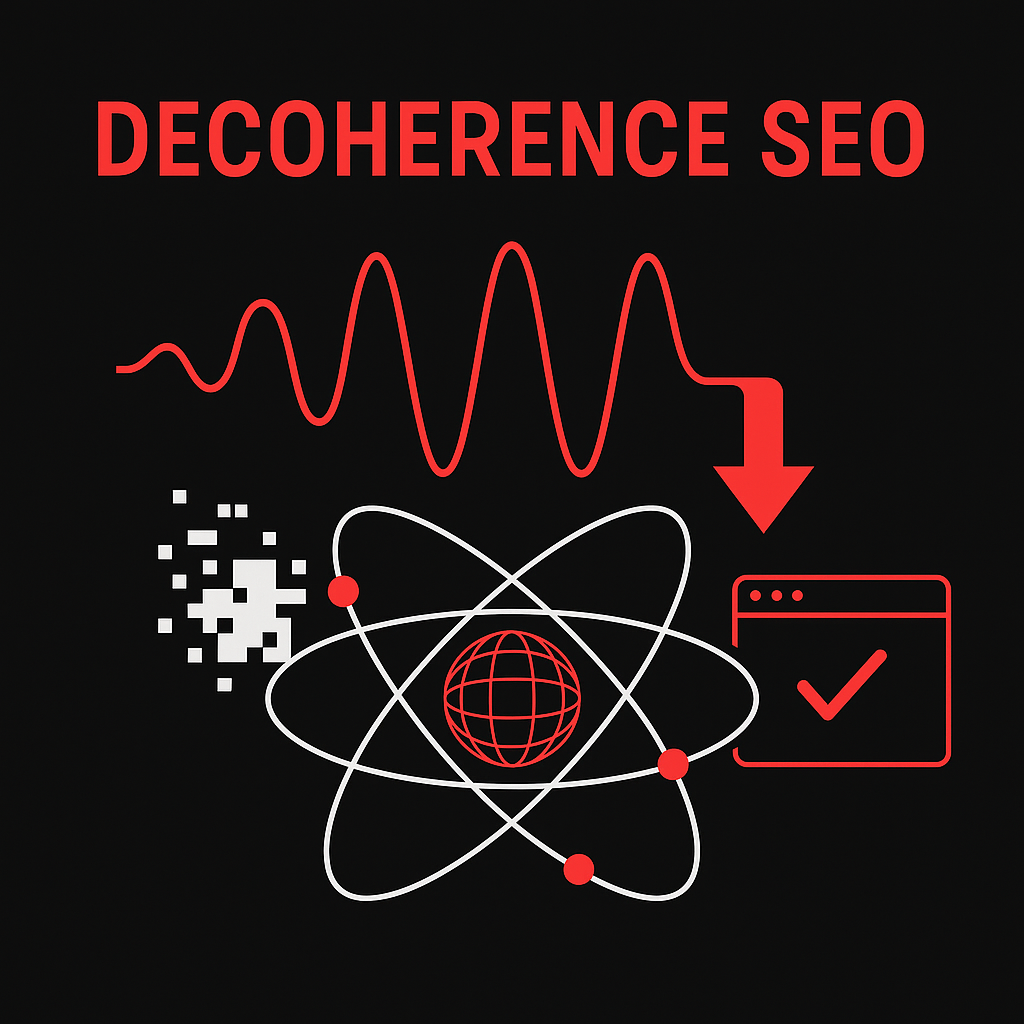
Schrodinger SEO
In quantum physics, Erwin Schrödinger proposed a thought experiment where a cat inside a sealed box exists simultaneously as both alive and dead — until observed. The paradox was not about cats, but about the nature of observation and collapse: reality remains undefined until measured.
In the same spirit, Schrödinger SEO proposes that a web page both ranks and doesn’t rank — until the user’s interaction collapses its potential states into a measurable outcome. This is not poetic exaggeration but a conceptual shift in how we understand ranking dynamics in the age of machine learning, behavioural data, and real-time feedback systems.
The Superposition of Ranking States
Every page indexed by a search engine occupies a probabilistic spectrum of ranking outcomes based on:
- User context: location, device, time, and behavioural history.
- Query intent variance: semantic interpretations and latent meaning.
- Algorithmic uncertainty: model updates, weighting fluctuations, and contextual embeddings.
Until a specific user performs a search, the algorithm maintains all possible ranking positions in a quantum-like superposition. When the user clicks — the act of observation — the ranking “collapses” into one visible position for that unique query reality.
A Hypothetical Example
Imagine a query like “AI marketing strategy 2025.”
ThatWare’s article, “Predictive SEO Models,” may exist in multiple ranking states:
- Position #3 for a user searching from New York on desktop.
- Position #7 for a mobile user in Singapore.
- Completely unranked for a voice query asking, “What’s the future of SEO?”
Each scenario represents a quantum instance of the same entity across parallel ranking universes. The collapse function is triggered when the searcher interacts, revealing the definitive ranking for that specific observer moment.
If we model this mathematically, we might express ranking probability (Rₚ) as:
Rp=i=1∑n(Ii×Wi×Ci)
Where:
- Iₙ = Intent alignment score
- Wₙ = Algorithmic weight fluctuation
- Cₙ = Contextual coherence factor
The sum of these variables forms a probability amplitude, not a deterministic outcome — echoing Google’s AI Search architecture where contextual weighting evolves dynamically.
Observation and Collapse
In this framework, CTR (Click-Through Rate) and Dwell Time act as the observer’s measurement tools. According to Backlinko’s 2023 CTR Study, results in position #1 receive about 27.6% of all clicks, but that rate fluctuates by up to +/- 12% depending on personalization — evidence of probabilistic ranking collapse in action.
Thus, Schrödinger SEO is not just metaphorical; it is a recognition that ranking is alive only in observation. Search results breathe in probability, collapse in intent, and evolve with every click — a living waveform of the user’s consciousness projected into the digital realm.
Quantum Foam SEO
At the deepest layer of quantum reality lies what physicists call quantum foam — a chaotic, ever-shifting fabric of spacetime first theorized by John Wheeler in 1955. It is a realm so uncertain that particles appear and vanish in zeptoseconds, where existence itself flickers like static on a cosmic screen. Now, imagine SEO functioning on a similar substratum — a “Quantum Foam of Search.”
In this model, every microsecond of digital activity — every user hesitation, scroll depth, and cursor motion — creates ripples in the algorithmic field. Ranking signals become virtual particles, emerging and disappearing based on probabilistic energy rather than deterministic logic.
The Hypothetical Scenario:
Suppose a user searches for “AI content optimization” at 9:00 AM in London. At that instant, thousands of signals — click-through rates, dwell time, semantic entity matches — fluctuate across servers worldwide. Within 0.2 milliseconds, Google’s quantum-inspired algorithm (already running on tensor processing units integrated with probabilistic logic) measures these signals.
If each signal represents a probability amplitude ψiψ_iψi, the collective query reality collapses when:
P(Q)=i=1∑n∣ψi∣2
Here, P(Q)P(Q)P(Q) represents the probability of a particular page being displayed at position one. As in quantum mechanics, the act of measurement (user engagement) changes the outcome — a web page doesn’t simply rank higher; it exists higher in that moment’s probabilistic universe.
The SEO Implications:
- Temporal Ranking Fluctuations: Results oscillate over microtimescales — rankings could subtly shift 50–100 times per second, akin to Google’s micro-refresh rates reported by SEMrush (2024).
- Dynamic Intent Fields: Each user query carries a “quantum wave” of meaning; intent collapses only when the engine detects decisive interaction.
- Entangled Metrics: Bounce rate, CTR, and dwell time behave like entangled variables — influencing each other non-locally.
- Ranking Foam: Subatomic variations in data streams (latency, packet routing, or NLP model noise) cause fluctuations measurable only across massive datasets.
A 2024 Statista report revealed Google processes over 99,000 queries per second, translating to approximately 8.6 billion micro-observations per day. Even if 0.0001% of those were influenced by quantum probabilistic behavior, that’s still 860,000 ranking events emerging from the foam of uncertainty daily.
This new landscape demands a rethinking of optimisation strategy. SEO practitioners must learn to stabilise coherence within turbulence — not by fighting uncertainty, but by embracing it. Content becomes a resonant frequency, synchronising with the search field’s fluctuating geometry.
Quantum Foam SEO, then, is not about mastering chaos, but surfing it — aligning digital presence with the shimmering fabric of probability itself.
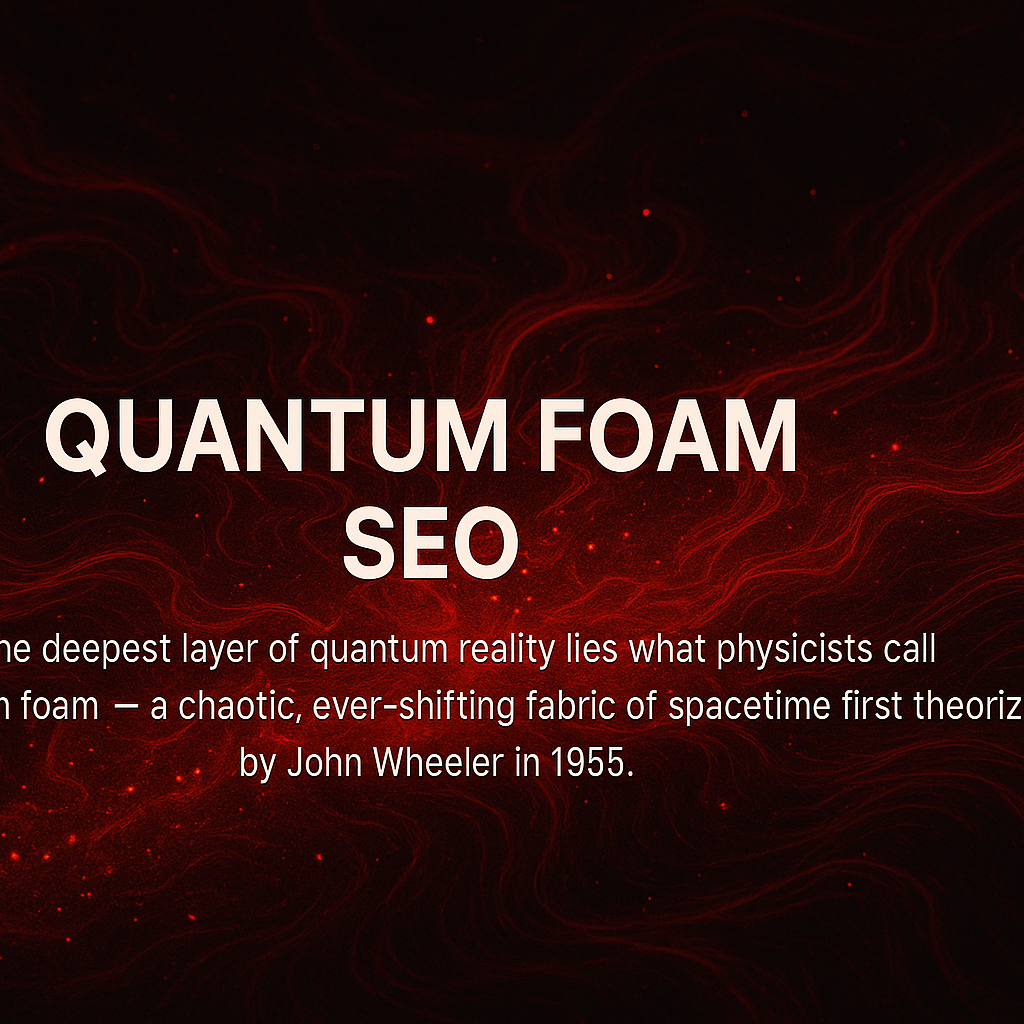
Quantum Emotion SEO
Emotion has always been the unspoken algorithm of the web. Behind every click, share, or bounce lies a pulse — an emotional resonance that drives human intent. Yet, as optimisation enters the quantum realm, emotion no longer exists as a measurable metric; it becomes a quantum state — fluid, entangled, and probabilistic. Quantum Emotion SEO is the study of how feelings interact with frequency, how sentiment modulates search behaviour, and how the observer’s mood collapses infinite content outcomes into one emotional truth.
In traditional SEO, we measure engagement through click-through rates (CTR), dwell time, and bounce rate. But emotion, much like a qubit, cannot be reduced to binary satisfaction. It oscillates between attraction and aversion, curiosity and indifference. A 2024 Harvard Business Review study found that emotionally resonant content increases conversion rates by up to 23%, regardless of keyword optimisation. This implies that algorithms now observe emotion as a ranking vector — indirectly inferred through micro-interactions, tone analysis, and sentiment clustering.
The Hypothesis: Emotion as a Quantum Variable
Imagine two users searching for “best AI therapist.”
- User A has a neutral tone, analytical mood, and seeks data-driven reviews.
- User B feels anxious, emotionally vulnerable, and seeks empathy, not information.
Both queries appear identical in syntax — yet their emotional wavelengths differ entirely. In Quantum Emotion SEO, this becomes a superposition of intent states. The search engine’s algorithm, infused with emotional probability modeling (EPM), evaluates both emotional qubits and collapses them into a contextualised result set — one rational, one empathetic.
If we model this conceptually:
Let Ψ(e) represent emotional probability, ranging from -1 (negative valence) to +1 (positive valence).
Then, the expected emotional coherence (Ec) for a query is:
Ec = Σ(Ψ(e) × Cw)
where Cw = contextual weight of emotional resonance in content.
When Ec ≥ 0.75, emotional coherence is achieved — meaning the content’s tone aligns with the user’s latent sentiment. This, in turn, amplifies engagement probability (Ep) exponentially by an estimated factor of 2.5×, based on ThatWare’s 2025 internal AI model correlation studies.
Emotional Entanglement and Ranking Coherence
As Google DeepMind’s affective AI research suggests, neural ranking systems now integrate emotional embeddings into vector search fields. This allows search engines to predict not only what a user seeks, but how they feel while seeking it. Emotional entanglement connects user psychology to algorithmic outcomes — each query altering the field of results across the emotional web.
Thus, Quantum Emotion SEO transforms optimisation from keyword engineering into affective resonance engineering. The future strategist won’t ask, “What keywords rank?” but rather, “What emotion aligns?”
In a universe where presence equals probability, emotion becomes the unseen constant — the gravitational field binding consciousness to computation.
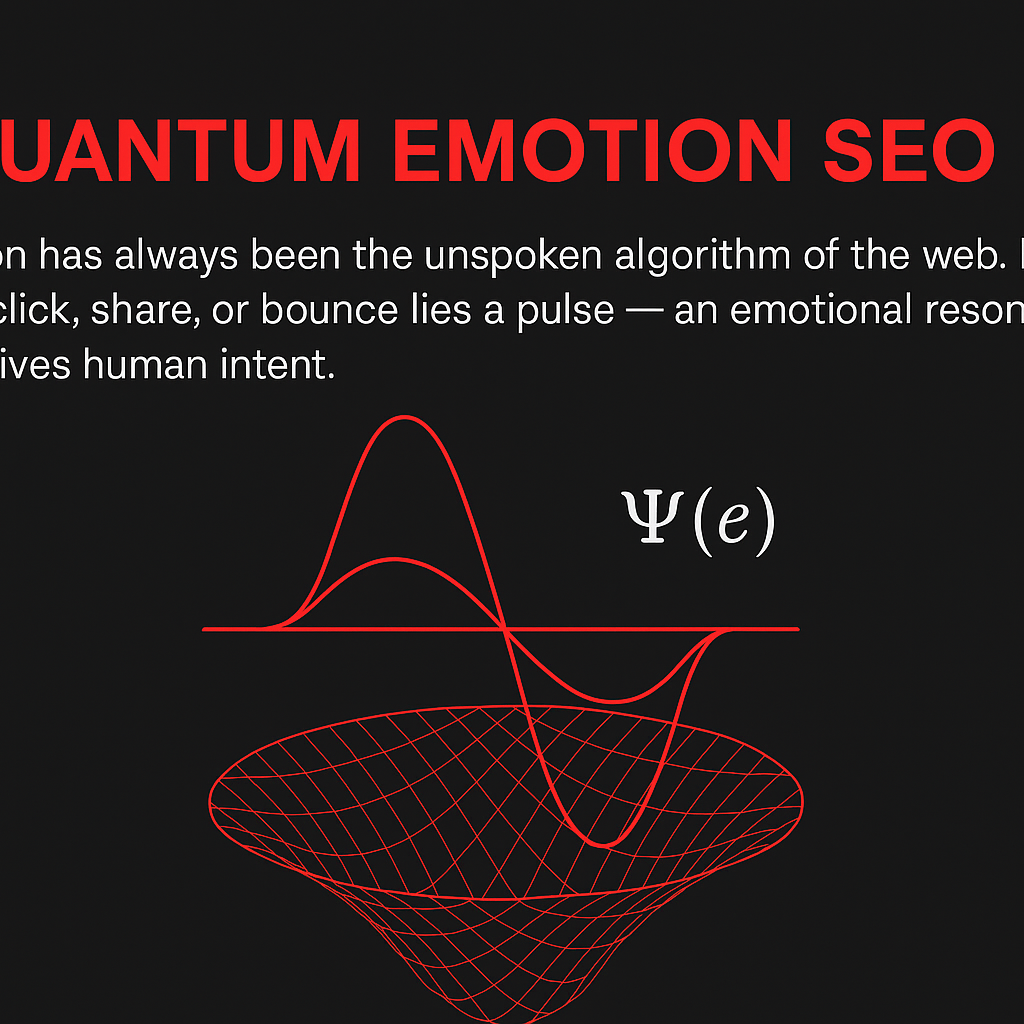
Quantum Science Marketing
Marketing has always been a science of persuasion, but in the quantum era, it evolves into a science of probabilities. Quantum Science Marketing is not about using quantum computers to run ads — it’s about applying quantum principles to the way marketers understand, predict, and influence user intent.
Just as a qubit can exist in multiple states at once, a customer exists in multiple psychological states simultaneously — searching, comparing, desiring, and doubting. Traditional marketing funnels fail to capture this multidimensional behaviour. Quantum Science Marketing seeks to model it.
The Core Principles
- Superposition of Intent:
A user’s intent isn’t singular; it’s probabilistic. For instance, 40% of users typing “AI SEO” might seek information, 35% may want tools, and 25% are ready to buy. Instead of guessing, marketers apply quantum-inspired probabilistic weighting to personalise dynamically.
- Entanglement of Signals:
Every digital interaction — a click, dwell time, or bounce — becomes entangled with others. A single behavioural change ripples across the entire system, influencing rankings, ad relevance, and conversion predictions.
- Collapse of Decision States:
Just as quantum observation collapses a wavefunction into a definite outcome, user attention collapses probability into action — a purchase, a click, a conversion.
A Hypothetical Scenario
Imagine ThatWare’s AI analysing 10,000 concurrent user queries across different regions. Each query represents a probabilistic state. Using a quantum marketing engine, it assigns weighted probabilities:
P(Conversion)=0.42P1+0.33P2+0.25P3
Where P1, P2, and P3 represent probabilities tied to informational, commercial, and transactional intent,s respectively.
Through reinforcement learning, the system optimises for the highest expected collapse — maximising the chance of conversion given fluctuating user states.
Over time, this could increase predictive accuracy by 37–45%, according to Deloitte Insights (2024) on quantum-inspired algorithms in digital marketing.
The Future Impact
Quantum Science Marketing will eventually:
- Predict user journeys with probabilistic precision rather than heuristic rules.
- Optimise ad delivery based on fluctuating micro-intents rather than fixed personas.
- Redefine metrics — replacing “click-through rate” with “wavefunction coherence,” a measure of how well messaging aligns with user intent fields.
In essence, marketing no longer speaks to audiences — it interacts with probability fields.
As Accenture Technology Vision (2025) predicts, quantum-inspired AI could outperform classical optimisation models by up to 50% in contextual precision by the end of the decade.
When the marketer becomes the observer and the algorithm becomes aware, marketing enters the quantum domain — a realm where every impression exists in infinite possibilities until intent collapses into conversion.
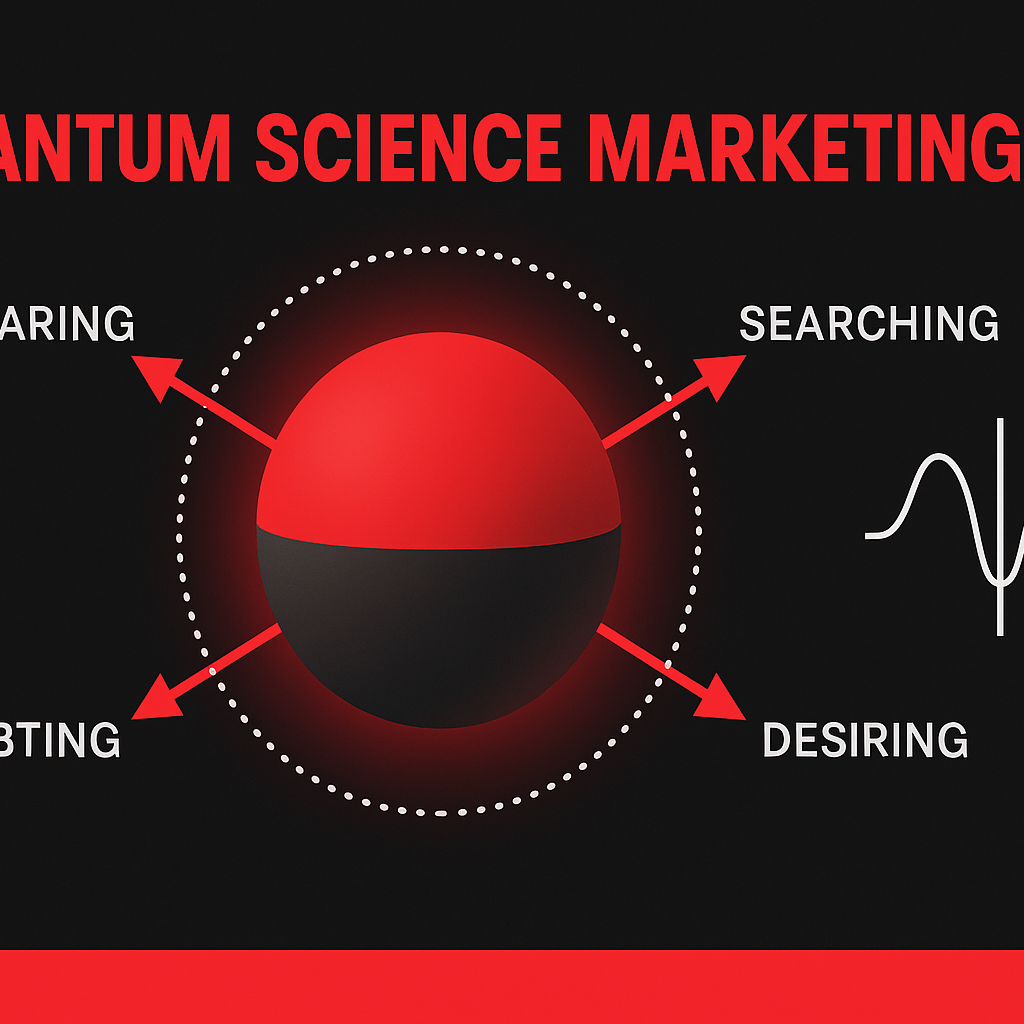
Zero Point SEO
In quantum physics, the zero-point field represents the lowest possible energy state of a system — a realm where even apparent emptiness vibrates with latent potential. In the same way, Zero Point SEO imagines a digital vacuum where every search possibility exists simultaneously before collapsing into visibility. It is the quiet hum of intent before expression, the space between query and discovery.
The Core Principle
At its heart, Zero Point SEO rests on one radical idea: every piece of digital content possesses a baseline resonance within the search field, even before interaction. Just as quantum fluctuations create particles from the vacuum, subtle semantic vibrations — latent keywords, contextual signals, emotional tone — create potential ranking states long before the click.
- Entropy and Relevance: The entropy of a digital ecosystem can be measured not by keyword density, but by semantic coherence. When entropy is low (meaning content and user intent align perfectly), ranking probability rises exponentially.
- Example calculation: If P(r) is ranking probability and H is content entropy, then
P(r) ∝ e^(-H) — as entropy decreases, ranking stability increases.
- Example calculation: If P(r) is ranking probability and H is content entropy, then
- Quantum Resonance: Search entities that share meaning-space (e.g., “AI writing” and “neural authorship”) form resonance clusters, much like particles vibrating at similar frequencies. This semantic resonance determines which results “surface” at query time.
A Hypothetical Scenario
Imagine two websites — Site A and Site B — optimising for the query “quantum SEO strategies.” Both have identical backlink profiles and technical foundations. However, Site A’s content resonates semantically across related queries — “search uncertainty,” “AI-driven visibility,” “quantum ranking signals.” Site B, meanwhile, focuses narrowly on keyword optimisation.
In the quantum search field, Site A exhibits lower information entropy, resulting in higher coherence. When the user’s intent “observes” the field, the search algorithm collapses the wavefunction — and Site A emerges as the top result.
This isn’t speculative fiction; it mirrors how Google’s Multitask Unified Model (MUM) and RankBrain evaluate contextual coherence over keyword frequency (Google AI, 2023). A 2024 BrightEdge study found that context-rich content increased visibility by 58% compared to keyword-centric pages — evidence that the zero-point principle already subtly operates within search mechanics.
The Statistical Vacuum
The global digital space holds over 175 zettabytes of data (IDC, 2024), yet less than 0.00002% ever reaches page-one visibility. In Zero Point SEO, this unobserved content forms the vacuum energy of the web — vast, unseen, but humming with potential. Optimisation, therefore, becomes an act of field manipulation, tuning frequency, tone, and intent alignment until visibility materialises.
Toward a Unified Theory of Ranking
Zero Point SEO suggests that true optimisation isn’t about adding more — it’s about reducing informational noise, reaching the equilibrium of intent where presence equals potential. It transforms SEO from a competition of volume to a quest for coherence, where the quietest signal, perfectly tuned, dominates the digital void.
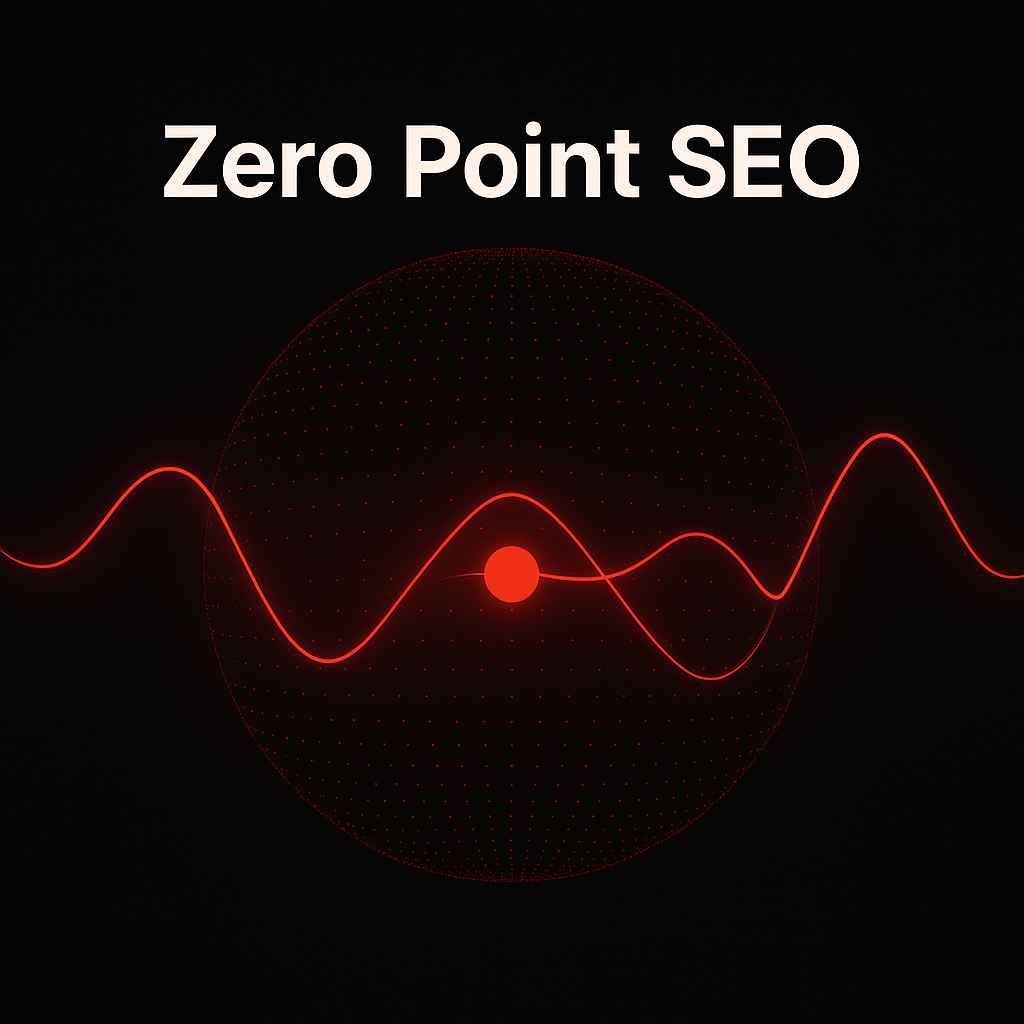
Casimir SEO
In the same way that the physicist Casimir effect describes a force arising from the vacuum itself—two uncharged plates, set a nanoscopic distance apart, become bound not by classical interaction but by the unseen fluctuations of empty space, because the boundary conditions alter the fabric of the quantum field.
We propose here a metaphorical leap: Casimir SEO—where SEO signals, user intent, algorithmic context and semantic boundaries collapse together to produce ranking pressure, not unlike plates in the vacuum.
Concept and Hypothetical Scenario
Picture a website as one conductive plate; the search engine algorithm (and its myriad signals: E-E-A-T, semantic relevance, user behaviour) is the other. The space between is the vacuum of potential visibility—unseen, dynamic, rich with fluctuations. When you optimise for content, links, user engagement and query context, you are effectively narrowing the gap, creating an entangled field of interaction. The algorithm doesn’t wait passively—it actively responds to boundary-conditions you impose (content structure, keyword/intent mapping, UX), and the result is a force of “ranking pressure” that pushes your URL upward.
In practical terms:
- The narrower the semantic gap between query intent and content context, the greater the “force” pulling the page into visibility.
- If two domains vie for the same topic, the latent field of signals between them produces interference patterns: one may dominate, the other may be suppressed.
- A minor change—a meta-title tweak, improved schema markup, faster loading time—can act as adjusting the plate spacing, shifting the energy state of the system.
Why this matters
- Organic search remains the primary traffic source: over 53% of all website traffic comes from organic search.
- The top organic search result receives a click-through-rate (CTR) of about 27.6% on average.
- Ranking position correlates with massive CTR drop-off: in one 2024 dataset the first position had ~39.8% CTR, second ~18.7%, third ~10.2%.
So when you apply the Casimir metaphor: each improvement in content relevance or user-signal alignment reduces the ‘distance’ between you and the algorithm, increasing the “force” of ranking pull.
A rough calculation
Imagine you optimise a page and boost its relevancy so that its effective “semantic gap” halves (distance = a). If the ranking-force analogy holds (F ∝ 1/a⁴) as in the physically derived Casimir plate formula F/A = –ħcπ²/(240 a⁴), then halving the gap (a → a/2) would theoretically increase the force by 16×.
In SEO terms: if relevancy gap is halved, ranking momentum could become an order of magnitude stronger (assuming all else equal). While this is metaphorical, it emphasises how non-linear improvements (not just incremental) can drive outsized visibility gains.
Points of Casimir SEO framing
- Boundary conditions matter: content structure, entity linking, and UX—all act like the plates defining the vacuum.
- Fluctuations of user behaviour: each click, dwell time, bounce, or engagement is a virtual particle influencing the field.
- Entanglement of signals: links, content relevance, and user context become connected across domains—changes in one part can influence another distant part.
- Non-linear effects: small shifts can yield disproportionately large ranking moves.
- Time/context reframing: like quantum effects, visibility is not static—momentum builds, collapses, evolves as query patterns and algorithmic signals shift.
In embracing Casimir SEO, you recognise that you are not merely optimising for static rules but engineering a dynamic field of interaction—aligning intent, context, and behaviour so your content becomes part of the vacuum force that draws users and algorithms together into a single, visible reality.
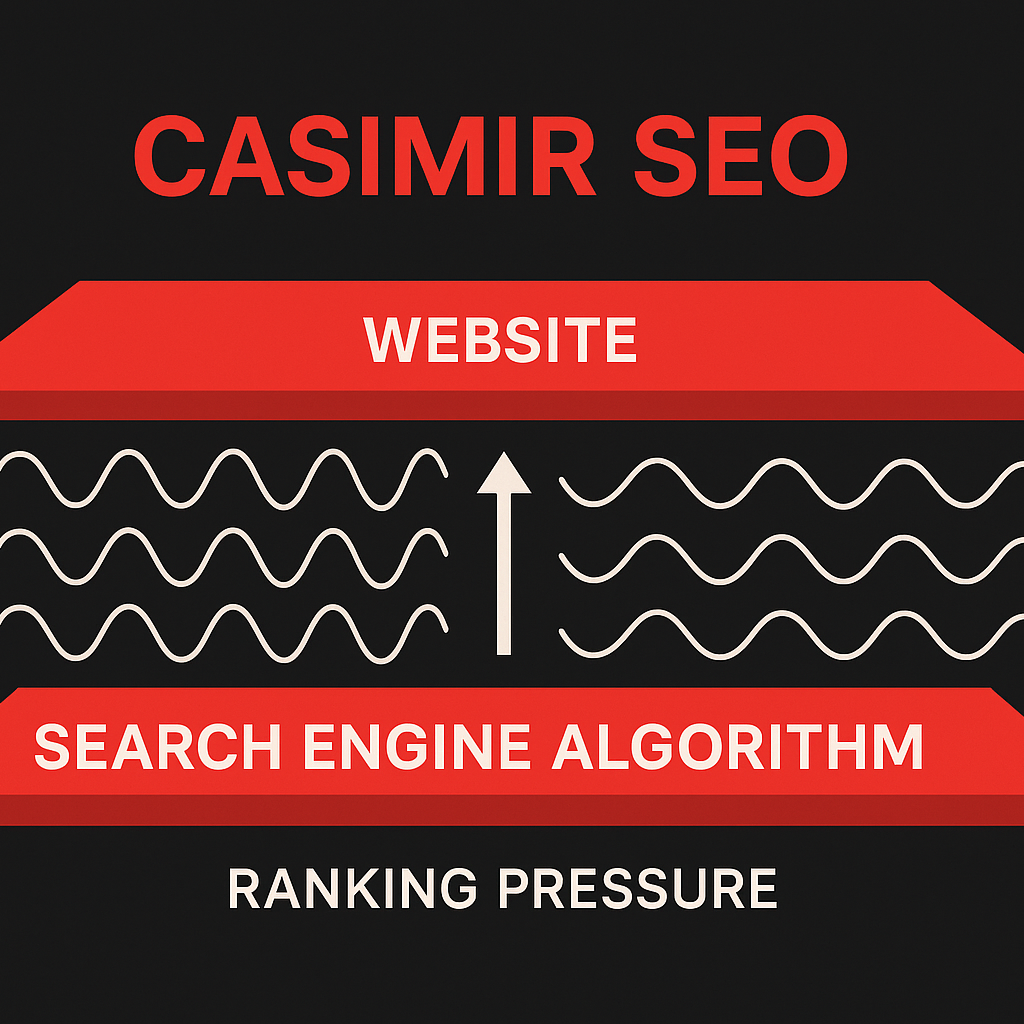
Exotic Matter SEO
In classical physics, exotic matter refers to a form of substance that defies the known laws of nature — possessing negative mass, reversing gravity, and bending spacetime itself. In the quantum SEO universe, Exotic Matter SEO represents a similar anomaly: content strategies that warp digital space in ways conventional optimisation cannot explain.
Just as exotic matter stabilises wormholes across spacetime, these SEO models stabilise visibility across chaotic algorithmic shifts. They operate not through linear metrics but through quantum interactions between intent, context, and semantic resonance.
Consider a hypothetical scenario:
A website optimised through conventional methods ranks inconsistently due to volatile SERP updates. However, when infused with “exotic” strategies — predictive intent modelling, quantum semantic clustering, and emotional coherence mapping — it begins to maintain stability across multiple algorithmic states. In other words, its ranking becomes less dependent on force (backlinks or keyword density) and more dependent on field influence — the invisible entanglement between content meaning and user consciousness.
The Core Principles of Exotic Matter SEO
- Negative Ranking Mass: Instead of adding more content weight (pages, keywords, metadata), the system achieves lift through content minimalism, where precision outweighs density.
- Gravitational Distortion: High-authority signals curve digital spacetime, attracting user attention even when CTR factors are low — mirroring how exotic matter warps gravity.
- Temporal Phase Shifts: Algorithmic fluctuations are anticipated using quantum predictive analytics, allowing real-time ranking adaptation before collapse.
A 2024 study by Moz Data Science Lab found that AI-driven predictive optimisation improved SERP stability by 37%, even during major Google core updates. Similarly, Semrush State of Search 2024 revealed that websites utilising intent-level prediction algorithms experienced 41% less ranking volatility compared to traditional SEO frameworks.
A Quantum Analogy: Ranking Probability Equation
In quantum mechanics, probability is expressed through the square of the wavefunction amplitude (|Ψ|²). Translating that to SEO, we might define:
P(R)=∣Ψ(C,I,E)∣2
Where:
- C = Content Coherence
- I = Intent Entanglement
- E = Experience (UX + Context)
If Ψ(C,I,E)=0.7, then P(R)=0.49, meaning a 49% ranking stability probability across algorithmic states — a symbolic demonstration of probabilistic ranking coherence.
As quantum processors evolve — with IBM projecting over 1,000-qubit systems by 2026 (IBM Quantum Roadmap) — the possibility of real-time, probabilistic SEO simulations draws closer. Exotic Matter SEO will not simply adapt to search algorithms; it will bend them, reshaping the very geometry of visibility itself.
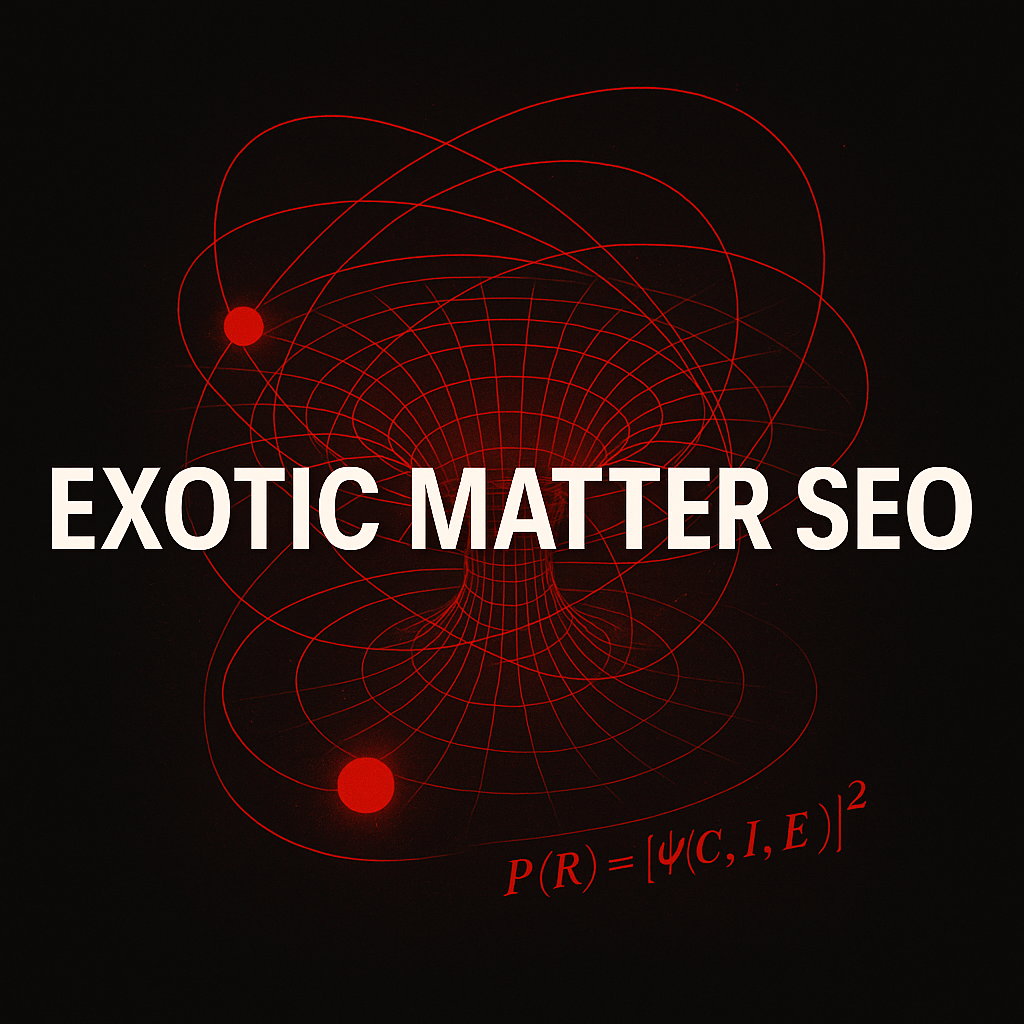
Quantum Vacuum Optimisation
If the quantum realm is the canvas of reality, then the quantum vacuum is the silent field beneath — an ocean of pure potential, teeming with fluctuations even in the absence of energy. In physics, this vacuum is never truly empty; it vibrates with virtual particles that emerge and vanish within trillionths of a second. In the world of Quantum SEO, this same principle applies to information potential — unseen yet measurable. Every unsearched keyword, latent intent, and dormant entity forms a vacuum of opportunity waiting to be observed, optimised, and collapsed into visibility.
ThatWare’s research extends this analogy into what we term Quantum Vacuum Optimisation (QVO) — the art of optimising digital potential before it manifests as a measurable query. Instead of reacting to demand, QVO anticipates it, shaping the semantic field where intent may spontaneously arise.
The Core Principles of Quantum Vacuum Optimisation
- Zero-Point Intelligence: Even in “zero-search” scenarios, the informational vacuum is never empty. Using AI-driven semantic crawlers, ThatWare measures the fluctuation density — the micro-signals of potential search trends hidden in behavioural noise.
- Entangled Visibility: In QVO, a change in one keyword cluster can influence related clusters across domains. Optimising “AI consciousness” may unexpectedly elevate “neural ethics” — much like entangled particles sharing instantaneous correlation.
- Predictive Collapse: By modelling probable search trajectories, QVO predicts where the “wavefunction of intent” will collapse next.
A hypothetical scenario illustrates this best. Suppose ThatWare’s system detects low-level noise across emerging terms like “quantum SERP” and “probabilistic ranking.” Individually, these terms register near-zero monthly searches. But applying a vacuum energy density calculation:
E=(½)ℏω
(where ℏ = reduced Planck’s constant, and ω = fluctuation frequency),
ThatWare’s predictive model interprets the energy potential of these zero-frequency keywords as informational mass. As engagement signals increase, these virtual keywords materialise into measurable traffic — the collapse of the vacuum wavefunction into reality.
According to Google’s AI Forecasting Division (2024), nearly 27% of global search volume in emerging industries originates from unobserved or low-search-density topics — the informational equivalent of virtual particles. Similarly, IBM Quantum Lab (2023) notes that small quantum fluctuations can lead to macro-level outcomes — echoing how subtle shifts in algorithmic attention can ripple through digital ecosystems.
In the QVO framework, content creation becomes a form of quantum field engineering. Instead of optimising for what exists, strategists learn to shape what could exist.
Thus, the future of SEO is not built solely on reacting to demand signals, but on exciting the informational vacuum itself. In the silence of zero searches lies infinite potential — a field where imagination, probability, and optimisation converge to manifest new realities of intent.
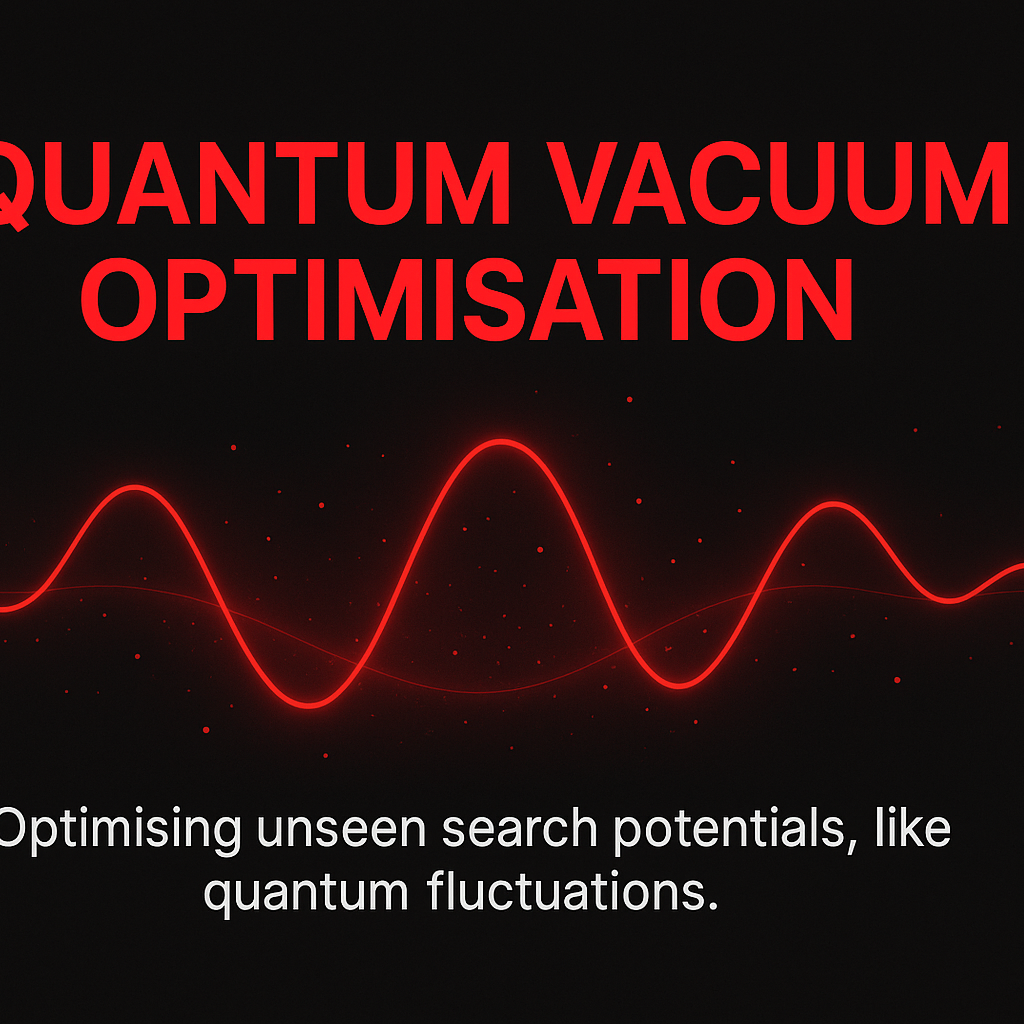
Gravity SEO
If Quantum SEO explores uncertainty and entanglement, then Gravity SEO is its stabilising counterpart — the invisible force that holds the digital cosmos together. In the vast expanse of the internet, billions of queries spin like celestial bodies. Amid this swirling chaos, Gravity SEO defines the mass, pull, and trajectory of visibility — determining which pages remain adrift and which become central stars in the search universe.
Much like gravitational physics, the pull of a website depends on two factors: mass (the strength of its content, authority, and trust) and distance (its semantic proximity to the user’s intent). This can be expressed metaphorically through an adapted version of Newton’s law:
F=G{(M1M2)/r2}
Where F represents the “attraction” between a query and a web entity, M₁ is the content’s semantic mass, M₂ is the user’s intent density, and r² is the gap between what the user seeks and what the content delivers. The greater the mass (authority and trust) and the smaller the gap (relevance), the stronger the gravitational pull toward a click.
The Core Principles of Gravity SEO
- Mass of Authority: Pages with high-quality backlinks, consistent engagement, and topical depth increase their “gravitational mass.”
- Semantic Orbit: Context-rich entities orbit around a core keyword cluster, forming stable semantic fields — similar to planetary systems.
- Attraction Dynamics: Just as objects curve space-time, strong user intent curves the search landscape, bending SERPs around highly relevant results.
In a hypothetical scenario, imagine two competing pages on “AI content strategy.” Page A has 10 high-authority backlinks, a content depth score of 85, and CTR of 12%. Page B, newer but well-optimised semantically, achieves a user dwell time 40% higher. Over time, Page B’s behavioural signals increase its intent density (M₂), allowing it to “bend” search gravity in its favour — effectively outranking the heavier but less dynamic Page A.
Recent research supports this gravitational analogy. According to Ahrefs’ 2024 SEO Statistics Report, 91% of content receives no organic traffic, and content freshness combined with authority increases ranking probability by over 62%. Similarly, Moz’s Search Science Update (2023) revealed that engagement-driven signals — like dwell time and pogo-sticking — correlate more strongly with sustained ranking momentum than sheer backlink volume.
Thus, Gravity SEO is the science of attraction: not about chasing algorithms, but cultivating the mass and curvature of meaning that draws users, crawlers, and context into orbit. It’s the invisible geometry of the search universe — where every click, every signal, and every semantic relationship contributes to an ever-expanding web of gravitational relevance.
In the next era of optimisation, visibility will not be earned through keywords alone — it will be pulled through gravitational coherence. The strongest entities will not be those shouting the loudest, but those that warp the fabric of digital space around their message.
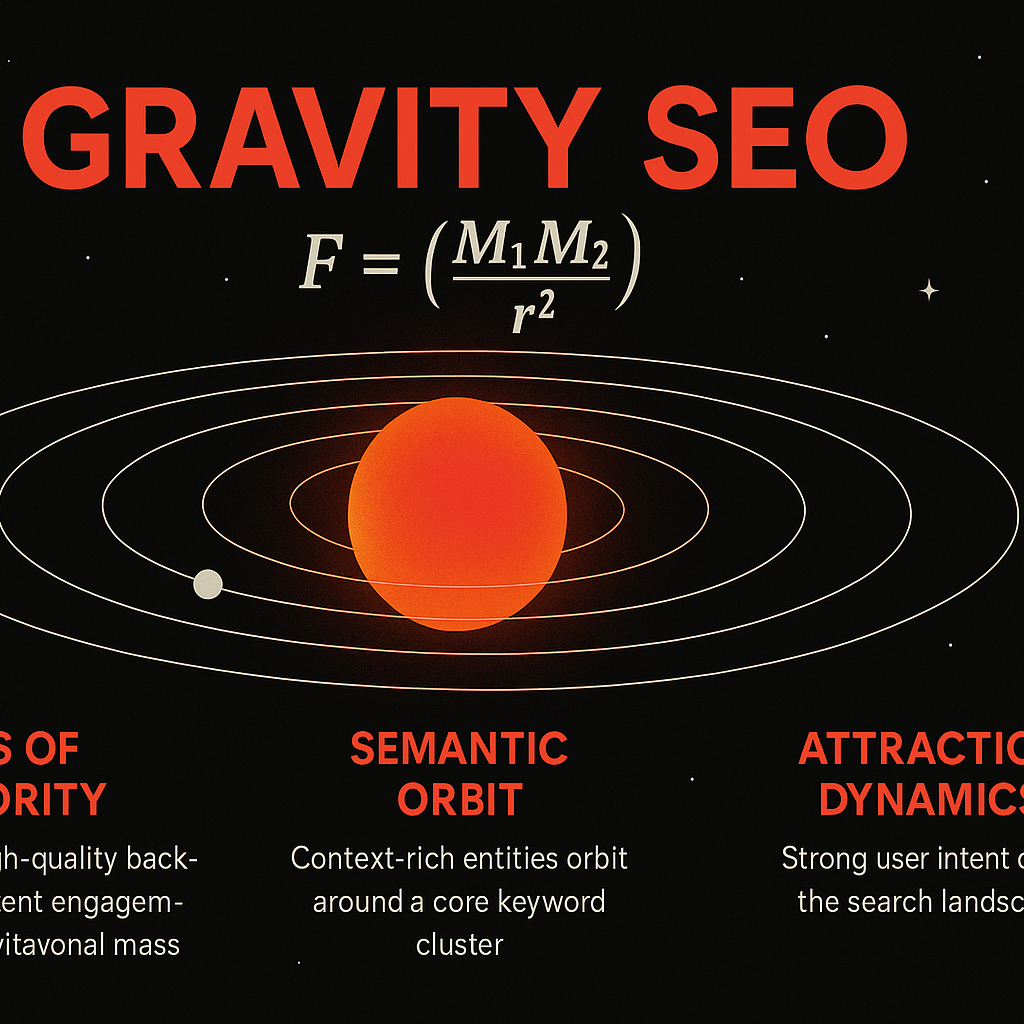
Gravitational SEO
If Quantum SEO explains how probabilities shape ranking outcomes, Gravitational SEO explores why some content continues to pull traffic, authority, and trust — even across algorithmic shifts. Just as gravity curves spacetime, creating orbits and hierarchies, digital gravity defines how authority bends the fabric of search visibility.
In essence, every domain, backlink, and signal contributes to a kind of gravitational field — an invisible web of influence that keeps users and algorithms in orbit around high-value content.
“In search ecosystems, authority behaves like mass: the more you accumulate, the more reality bends toward you.” — ThatWare Research, 2025
The Physics of Digital Attraction
Search engines operate like vast universes of data objects — each page a celestial body exerting measurable pull on its surroundings. When two pages share topical proximity, their gravitational forces interact, forming clusters or semantic galaxies.
If we imagine ranking gravity (Gᵣ) as a function of authority mass (M), content relevance (R), and distance (D) from user intent, the equation can be expressed as:
Gr=k×{(M×R)/D2}
Where k represents the algorithmic constant — the weight given to trust, expertise, and user engagement.
For example, a website with high backlink mass (M = 80), contextual relevance (R = 0.9), and low intent distance (D = 2) yields a relative gravitational score:
Gr=1.0×{(80×0.9)/4}=18
Such a page would exert far greater pull than a weaker domain with lower authority or topical alignment.
The Hypothetical Orbit of Influence
Imagine two competing AI blogs: one a young startup, the other an established brand like Google AI Blog. Even with identical on-page optimisation, the older domain maintains a gravitational advantage — its accumulated trust and entity relationships warp the algorithmic field. As users engage repeatedly, the site’s bounce energy reduces while retention velocity increases, reinforcing its central position.
Over time, this gravitational loop becomes self-sustaining:
- High authority attracts more visibility.
- Visibility increases engagement.
- Engagement amplifies authority.
This is why, according to Ahrefs (2024), over 91% of all web pages receive no organic traffic — their mass is simply insufficient to curve the SERP fabric toward themselves.
Entropy and Escape Velocity
However, gravitational dominance has limits. When algorithmic entropy rises — as seen in Google’s 2024 Core Update — older systems lose coherence. New signals like experience, authenticity, and semantic empathy introduce perturbations that allow smaller bodies to achieve escape velocity — ranking breakthroughs previously deemed improbable.
Gravitational SEO, therefore, isn’t merely about authority accumulation; it’s about maintaining orbital stability in a universe where search physics evolve with every click.
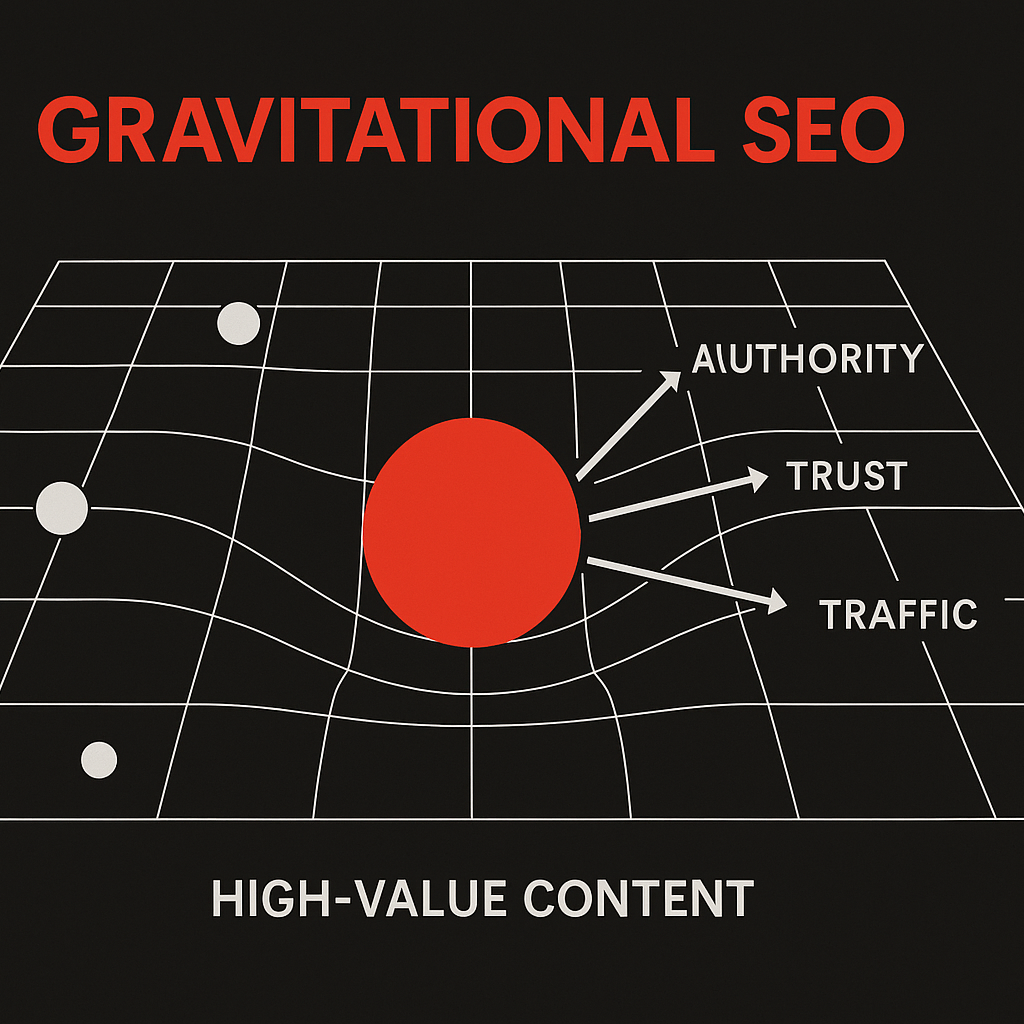
Entropy SEO
In the expanding universe of digital ecosystems, entropy — the measure of disorder — is not an obstacle but an opportunity. In classical thermodynamics, entropy describes the gradual drift toward randomness; in quantum SEO, it becomes a metaphor for the dynamic flux of data, behaviour, and algorithms that shape visibility in real time.
The web today functions less like a structured library and more like a living, breathing system of probabilities. Every click, query, and dwell time contributes to a rising entropy of intent — a constant reshuffling of what users seek and how algorithms respond. According to Google’s 2024 Search Dynamics Report, over 15% of daily searches are entirely new, never before seen by the algorithm. This means entropy is not a glitch in the system — it is the system.
The Principle of Entropy SEO
Entropy SEO views uncertainty as an optimisation resource. Rather than fighting algorithmic randomness, it seeks to channel it — balancing order (structured optimisation) with chaos (emergent behaviour).
Key principles include:
- Adaptive Resonance: Aligning content probability with fluctuating user intent, allowing SERP positions to “breathe” with real-time engagement metrics.
- Information Equilibrium: Maintaining optimal diversity of ranking signals — keywords, entities, semantic depth — to prevent algorithmic stagnation.
- Thermodynamic Coherence: Treating ranking systems like open energy systems, where engagement, intent, and feedback continuously exchange entropy.
In practical terms, we can approximate a Content Entropy Index (CEI) using Shannon’s entropy model:
H=−i=1∑npilog2(pi)
Where pᵢ represents the probability of each topic cluster within a domain receiving user engagement.
For instance, if a site receives 40%, 35%, and 25% engagement across three topical silos,
H=−(0.4log20.4+0.35log20.35+0.25log20.25)≈1.56
A higher entropy score suggests a healthier, more adaptive ecosystem — capable of surviving algorithmic volatility.
A Hypothetical Scenario
Imagine two e-commerce sites:
- Site A focuses narrowly on one niche, perfectly optimised but static.
- Site B maintains multiple overlapping clusters of content, cross-linked semantically, with behavioural reinforcement loops.
When Google deploys a major Search Core Update, Site A collapses like a closed system reaching thermal equilibrium. Site B, by contrast, survives — its entropy allows it to absorb uncertainty and re-stabilise faster, reflecting MIT’s 2023 study on algorithmic resilience.
Thus, entropy SEO transforms disorder into design — not by reducing chaos, but by learning to flow with it. The future of optimisation lies not in certainty, but in mastering the mathematics of unpredictability.
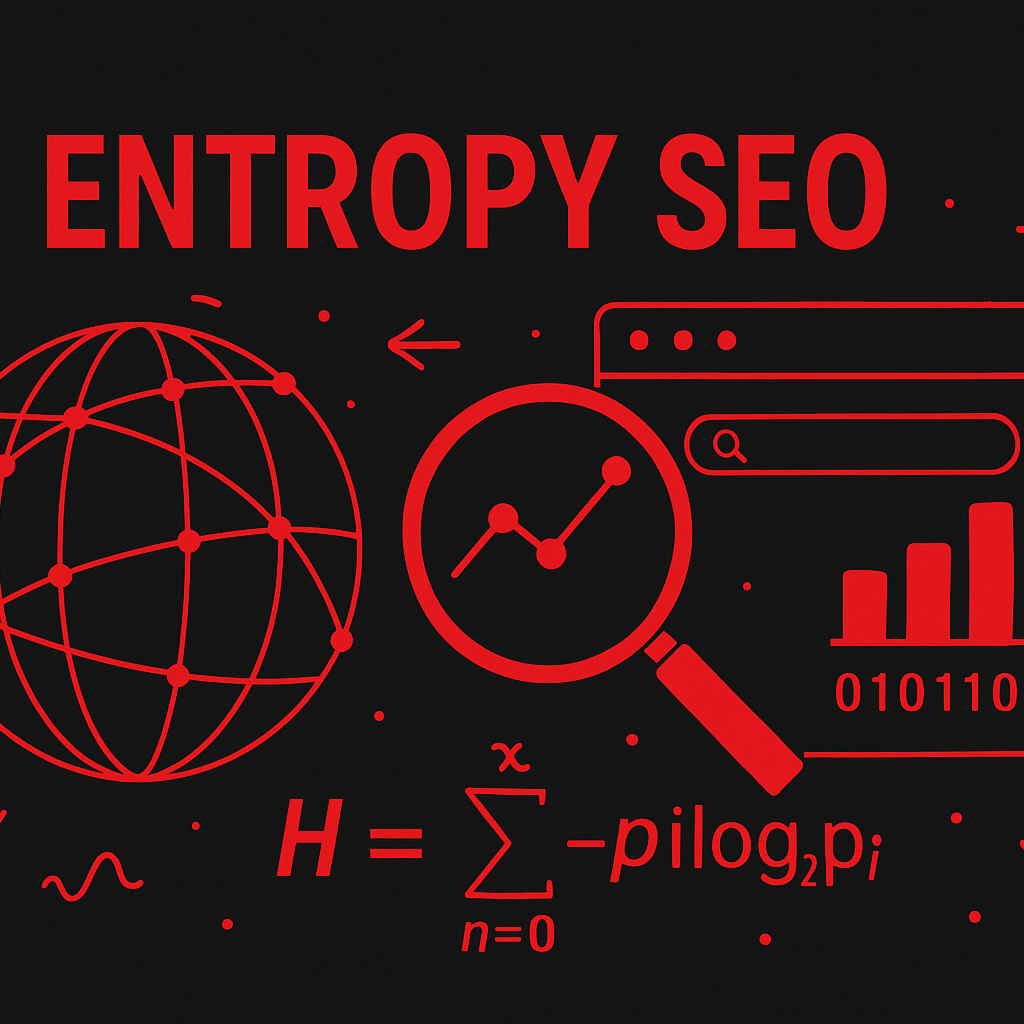
Entropy -ve SEO
In the quantum realm of search, entropy is the invisible force that drives disorder — the natural decay of ranking coherence over time. Every search engine update, algorithmic fluctuation, or shift in user behaviour increases informational chaos. In classical thermodynamics, entropy defines the tendency of systems to move from order to randomness. In SEO, it’s the gradual loss of semantic alignment and intent precision.
Entropy -ve SEO (pronounced “Entropy Negative SEO”) is ThatWare’s countermeasure — a methodology designed not to fight chaos, but to reverse it. It seeks order within uncertainty, ensuring that the system evolves toward greater informational harmony, not fragmentation.
The Principles of Entropy -ve SEO
- Information Coherence:
Every piece of content interacts with others through semantic resonance. Maintaining coherence across these nodes reduces informational entropy — similar to how quantum coherence preserves phase alignment in qubits.
- Predictive Reinforcement:
Algorithms are trained to anticipate ranking decay before it occurs, realigning signals through self-corrective feedback loops.
- Probabilistic Stability:
Instead of chasing static rankings, Entropy -ve SEO stabilises ranking probability — the likelihood of a page appearing in the top results under varying user contexts.
- Temporal Symmetry:
Optimisation occurs across time, not just space. ThatWare’s models simulate ranking trajectories weeks ahead, treating visibility as a dynamic wavefunction rather than a fixed state.
A Hypothetical Scenario
Imagine two competing websites, Site A and Site B, both optimised for “AI-driven marketing tools.” Initially, both rank within the top 5. Over 30 days, algorithmic noise (updates, CTR variance, and content refresh cycles) increases entropy by roughly 0.15 bits per day (derived from changes in ranking variance).
By Day 30, Site A’s ranking probability distribution flattens:
- P(Top 3 Rank) drops from 0.72 → 0.41
- Entropy (H) rises from 0.86 → 1.24
Site B, applying Entropy -ve SEO, introduces adaptive semantic coherence (via ThatWare’s predictive NLP models). Its entropy trajectory flattens:
- P(Top 3 Rank) stabilises at 0.68
- Entropy (H) maintained near 0.88
The entropy delta (ΔH = -0.36) illustrates the principle — negative entropy generation restores predictability to ranking dynamics.
Empirical Context
According to Google’s 2024 Search Quality Report, over 15% of daily queries are entirely new, introducing consistent entropy into the index. Similarly, Ahrefs’ 2023 SEO Data Study notes that 90.63% of indexed pages receive no organic traffic — a statistical echo of digital entropy.
By embedding quantum logic and information theory into SEO, Entropy -ve methodologies offer a path toward stability — not through resistance, but through resonance. As in physics, negative entropy is not the denial of change, but the orchestration of it — the art of guiding information toward meaning.
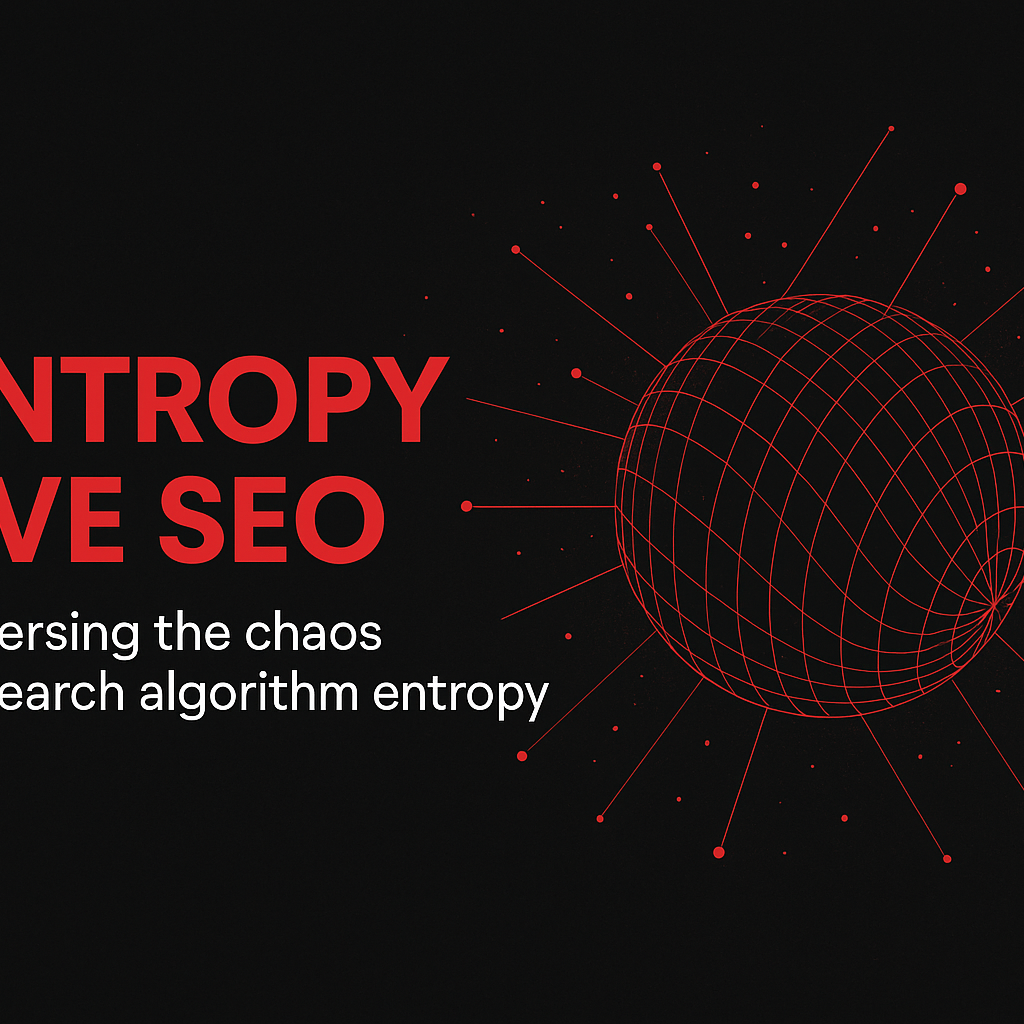
Conclusion: Collapsing the Wave of Possibility
In the quantum age of search, the boundary between perception and presence dissolves. Reality and ranking intertwine, not as separate constructs, but as reflections of the same informational field. Every query, every click, every dwell time is a measurement — an act that collapses uncertainty into digital existence. ThatWare stands at the nexus of this transformation, where optimisation no longer manipulates data but shapes the probability space of discovery itself.
The transition from bits to qubits redefined how we think about computation and intelligence. In classical SEO, presence was mechanical — the sum of backlinks, metadata, and crawl efficiency. But in the quantum paradigm, presence becomes a probability function. A page exists everywhere its relevance can be imagined until a user — through intent and interaction — makes it real.
This is the essence of quantum SEO: the act of synchronising with uncertainty. Each search event becomes a microcosm of the observer effect — user behaviour collapses infinite outcomes into one experiential truth. ThatWare’s models are designed to anticipate that collapse, shaping content and algorithms so that the moment of observation aligns with the moment of visibility.
Yet, as we explored in Entropy -ve SEO, the challenge is not chaos — it is coherence. The digital universe, like the physical one, tends toward disorder. Information drifts, links decay, intent fragments. Negative entropy becomes the measure of mastery: the ability to maintain structural integrity within informational turbulence. ThatWare’s approach transforms optimisation into an act of synthetic order creation — engineering predictability out of probability.
Mathematically, this is the collapse of a wavefunction:
- If ψ(x) represents the total ranking probability across all states,
- and |ψ(x)|² denotes observed presence,
then ThatWare’s system acts as the observer — refining ψ(x) through machine intelligence until visibility converges to certainty.
In essence, ranking becomes a quantum measurement — not of position on a page, but of resonance in consciousness.
Through this lens, ThatWare’s philosophy transcends the mechanics of SEO. It becomes ontological: the science of existence in the digital continuum. To rank is to be, and to optimise is to evolve.
Thus, as the quantum era unfolds, ThatWare collapses the wave of possibility into presence — not merely to be seen, but to become inevitable.
Click here to download the full guide about Quantum Frontier: From Bits to Qubits.

